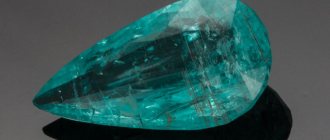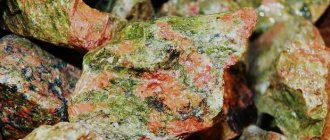Over the past two decades, there has been much talk about the looming imbalance between supply and demand in the diamond industry. The huge mines discovered over the past 40 years are almost exhausted. But over the past few years, diamond production has become fairly stable at about 130 million carats per year. The most recent major mine discoveries have been made in Canada, with the largest being the Gahcho Kue mine. Production from this mine will be approximately 5 million carats per year. But how does it compare to other major diamond mines in the world?
Let's find out by looking at the 10 largest diamond mines.
№10
Name : Botuobinskaya Where : Russia Reserve estimate : 69.3 million carats
The newest member of this elite group of mines is the Botuobinskaya mine, located in the Nakyn kimberlite deposit, approximately 200 km northwest of Nyurba in the Yakutsk region. Production at the mine began in 2015, and in 2016 it reached 1.5 million carats. The mine is located just three kilometers from the Nyurbinskaya pipe, which is the main asset of the Nakyn deposit.
As of January 1, 2015, Botuobinskaya’s reserves amount to 69.3 million carats, and production there will continue for more than 30 years. This is the first large diamond mine opened in the Yakutsk region of Russia in recent years. The mine is managed by Russian mining giant ALROSA.
№9
Name : Venice Where : South Africa Reserve estimate : 71.8 million carats
Diamond-bearing rocks were discovered in the Venetian mine area back in 1903. In 1969, De Beers began a project to find the source of these diamonds, and in 1980 they opened Venice. Construction began in 1990, and by 1993 the mine was fully operational. It is currently the largest diamond mine in South Africa, located northwest of the Kruger National Park near the border with Zimbabwe.
Applications of diamonds
After cleaning, the diamonds are sent to sorting centers. There they are distributed according to four characteristics:
Diamond Sorting Center
- weight (carat);
- form;
- quality (absence, presence of defects);
- color.
Since no two diamonds are the same, they can be distributed over more than 8 thousand positions.
By application, diamonds are divided into two categories:
- jewelry;
- technical.
Jewelry diamonds make up 70% of the total. They undergo multi-stage processing: sorting, certification, marking, splitting, peeling, cutting. During the processing process, a diamond can lose up to 60% of its original mass. Treated diamonds are called polished diamonds. And they are already used in the creation of jewelry.
The second category of diamonds is technical. These diamonds have industrial purposes. They are used in the production of stoneworking tools, metalworking tools, medical instruments, and the watch industry.
№8
Name : diamond mine named after. V. Grib Where : Russia Estimated reserves : 91.5 million carats
This is the only large diamond mine in Russia that is not operated by ALROSA. The field was discovered by oil and gas giant Lukoil while searching for natural gas in the Arkhangelsk region.
Analysts expect Lukoil to sell this mine. But it turned out to be profitable at a time when the company was forced to write down other assets due to falling global oil prices. The mine's reserves are estimated at 91.5 million carats and production is expected to continue for 20 years. Production figures continue to grow.
№7
Name : Argyle Where : Australia Reserve estimate : 93.1 million carats
Although Australia's Argyle mine is reaching the end of its life, it is the largest diamond producer in history and has produced more than 750 million carats since 1982. After 30 years of open-pit mining, the mine switched to fully underground mining in 2014.
Although the mine's reserves are still estimated at 93 million carats, production levels in 2016 were only 16.8 million carats and the mine is expected to be fully depleted by 2022. The mine is located in a very remote area of Western Australia, where summer temperatures regularly exceed 40 degrees. The mine was first opened in 1979 and is the world's only economically viable lamproite diamond mine.
Argyle is a very large and important source of both low-quality diamonds and fancy pink and red diamonds. Its permanent closure will undoubtedly have a significant impact on the diamond industry and change the face of the world's diamond supply.
№6
Name : Mir (Mirny) Where : Russia Reserve estimate : 97.4 million carats
The Mir Mine is an awe-inspiring place and is now the second largest well dug on Earth. It is so large that flying over the mine is prohibited due to reports of aircraft being sucked into the mine due to variations in temperature and pressure around the well. Its diameter is almost 1.2 km, and its depth is more than 500 meters. The mine played a very important role in the development of the diamond industry.
The mine was first opened in 1955 and production began in the early 1960s. It is located in one of the harshest environments on the planet, and miners have reportedly used jet engines to thaw the permafrost in the area. An open-pit mine, it produced up to 10 million carats a year for decades before closing in 2001. In 2009, diamond mining began again at the mine.
The mine has been operating as an underground mine since 2014 and produces approximately 2.2 million carats per year, with a planned increase to 4 million carats per year.
Interesting Facts
Interesting facts about the discovery and development of a diamond deposit include the following:
- The discoverers of the diamond quarry were a geological exploration group, headed by Yu.I. Khabardin, awarded the Lenin Prize. In addition, the leadership of the expedition included E.N. Elagin and V.P. Avdeenko.
- Within 2 years after the start of work, the deposit became the diamond center of the Soviet Union. Until 2001, it brought the greatest income among all similar places, first for the USSR, and after its collapse - for Russia. During this time, the quarry not only became a source of cash income, but also turned into a landmark of the country. To view it, an observation deck has been built nearby, which offers a unique view of the huge funnel.
- It was here that the largest diamond was found in 1980. Its weight was 68 g. This year the next party congress took place and in honor of this event the stone was named: “XXVI Congress of the CPSU.”
- The Mir deposit is located in a place where the temperature often drops below 60 degrees below zero. In isolated cases it can reach minus 70°C.
- Considering the depth of the crater is 525 m, the mine is one of the deepest places on the globe.
- During its entire existence, the quarry was reconstructed 3 times. From 2001 to 2009 was completely preserved. The problem of mining diamonds underground was being solved, since readily available minerals had been exhausted. This is currently being done by the Mirny Mining and Processing Plant.
- According to legend, the mine has mystical powers. It not only attracts you with its scale, but also with the desire to jump there with a parachute. However, this cannot be done, because the pit has a force that sucks in aircraft due to the turbulence of the air masses.
- It should be taken into account that the territory is closed, so tour operators do not offer tours here. Those who want to get to this place need to rely only on their own strength and use the services of aviation companies. A direct flight can be made from Yakutsk, the capital of Yakutia. It is easy to reach from anywhere in the country. The remaining distance to the city of Mirny will be 820 km. A small plane overcomes it in a little more than 2 hours.
The deepest diamond quarry, located in the city of Mirny in Yakutia, is a unique natural phenomenon. Luckily, camberlite ores containing diamonds came to the surface along with gases from the depths of the earth. After mining easily accessible stones, the task of mankind is to get the rest of them by building underground tunnels.
Article design: Oleg Lozinsky
№5
Name : Udachny Where : Russia Reserve estimate : 108 million carats
Udachny was the richest mine in Russian history and could be considered a twin of Mir. It is 640 meters deep and is so steep in some places that it poses a transport risk. The open pit has been in operation since 1971 and has produced $80 billion in diamonds from 340 million tons of ore. Like Mir, Udachny has moved to a fully underground mine with a development plan of over $800 million currently under development.
Underground mining could extend the life of the Udachny mine by more than 50 years, and it is likely to remain one of the world's most important sources of diamonds for decades. The mine plan calls for a maximum underground mining depth of 1.4 km below the surface.
№4
Name : Catoca Where : Angola Reserve estimate : 110 million carats
Catoca is Angola's largest diamond mine, accounting for 70% of the country's production. It was first opened in 1965. The mine was developed in 1994 and is owned and operated by the joint venture Sociedade Mineira de Catoca, which includes, among others, the state-owned mining company ENDIAMA and the Russian one. The mine began production in 1997, and in 2005 a major mine expansion project was implemented.
In 2016, Catoca produced approximately 6.5 million carats of diamonds, making it one of the largest diamond mines in the world. The mine's current diamond reserves are estimated at 110 million carats, and the projected mine life is until 2034, after which the mine will reach a depth of 600 meters. It will then move to underground mining for another 6-8 years.
№3
Name : Yubileiny Where : Russia Estimated reserves : 125.4 million carats
The Jubilee mine was the largest diamond mine in the world for many years, but it has fallen to fourth place due to high production rates at other mines over the past few years. Production at the mine in 2015 is estimated at 9 million carats. However, with the addition of unproven underground reserves, it could still be the largest diamond mine on the planet.
The Yubileiny mine was opened in the Yakutsk region in northern Russia and has been mining since 1986. It continues to be the most fertile deposit in Russia, its productivity and income are more than twice the income of the mine named after. V. Grib.
Diamond mining technology
There are two technologies for developing diamond mines. Open and closed. Open technology consists of excavating a quarry at the location of the kimberlite pipe. For this purpose, blasting operations are carried out throughout the quarry. The drilling rig creates holes into which the explosive component is placed. After the explosion, the diamond-bearing ore is transported to processing plants for processing. There, the ore undergoes crushing procedures and a multi-level process for separating diamonds from the ore. The resulting diamonds are sent for sorting and processing.
Kimberlite pipe "Mir"
The largest open-pit mine is the Mir kimberlite pipe, which is located in Russia. Its depth is 525 meters and its diameter is 1200 meters. After 44 years of operation, open-pit diamond mining at the quarry has been stopped. For reasons of economy and safety, a closed type is being developed.
The closed type involves digging shafts that go deep into the tube. Thus, it is planned to mine ore at the Mir mine for another 34 years. After the ore is delivered to the surface, processing procedures are carried out.
Since the main diamond deposits in Russia are concentrated in Yakutia, which has rather harsh weather conditions, the construction of mines here has its own characteristics.
Firstly, a large accumulation of groundwater greatly complicates construction; it has to be constantly pumped out.
Underground machines are equipped with powerful nozzles with metal spikes that cut into the rock and crush it
The waters here have high mineralization and can even dissolve car tires. The process of pumping out groundwater continues continuously during the operation of the mine using pumps.
Secondly, 400 meters of the earth’s crust is located in the permafrost zone, which makes it difficult to remove layers of waste rock during the construction of mines.
Thirdly, bad weather conditions negatively affect the use of manual labor; miners and builders can only work for 2–3 hours, and a large staff of employees is required to ensure a normal production process. More than 70% of the population of the city of Mirny, which is located near the mine of the same name, are employees of the ALROSA diamond mining enterprise.
Diamond mining in the mine is carried out according to a standard scheme, similar to the mining of coal or other minerals - combine mining. Underground machines are equipped with powerful attachments containing metal spikes that cut into the rock and crush it. The ore is then collected by excavator buckets and loaded into an underground elevator, which is a cage with a lift. Diamond ore extracted in this way is sent for further processing.
All stages of diamond mining
№2
Name : Jwaneng Where : Botswana Reserve estimate : 149.1 million carats
It's no surprise that the world's most productive diamond mine by value is also one of the largest. The Jwaneng mine is located 160 kilometers southwest of Gaborone in southern Botswana. "Jwaneng" means "place of small stones".
Jwaneng is owned and operated by Debswana, a joint venture between De Beers and the Government of Botswana. The mine was opened in 1972. The mine produced more than 22 million carats in 2010 and is expected to continue producing between 12 and 15 million carats per year.
Industrial processing of diamond ore
Wet autogenous grinding mill
The extracted rock from diamond mines is sent to processing plants, which are located near the deposits. Since rock layers can reach 1.5 - 2 meters, at the first stage they are crushed into smaller ones. This is done using jaw crushers; the output is raw materials crushed to 50 cm.
At the next stage, the crushed pores are sorted using a vibrating sieve; it consists of several tiers, each subsequent one has smaller fractions. Using pulsating jets of water, the waste rock is separated from the diamond compounds. This method is applied to stones of large and medium fractions.
For fine-grained material, pneumofloration is used - the use of chemical reagents, interacting with water, they form foam to which diamond particles stick.
Pneumatic flotation machine
These methods, along with diamonds, also allow ore particles to pass through, so another cleaning method is used using X-rays.
The conveyor delivers the raw materials to specially equipped containers, where the ore is irradiated; when the beam hits them, the diamonds luminesce, which is responded to by air supply units that blow the stone out of the total mass. This is the most effective cleaning method, but, unfortunately, it does not remove impurities from the stones.
Therefore, the share of manual labor at processing plants is high. After industrial processing, each stone goes through at least three more specialists who remove unnecessary impurities and sort it by size and degree of purity.
№1
Name : Orapa Where : Botswana Reserve estimate : 151.4 million carats
According to De Beers, the Orapa mine saw a significant increase in reserves in 2015 after additional drilling at depth allowed the company to raise inferred resources into the mine's reserve base. This helped raise Orapa to the first place in terms of diamond reserves in the mine on Earth.
The Botswana mine is located approximately 500 km northwest of the capital Gaborone in central Botswana. Orapa, which means "resting place of lions", was discovered in the 1960s shortly after Botswana gained independence from Britain. The mine began production in 1971 and has been one of the world's most productive since peaking at 17.3 million carats in 2006.
These 10 prolific mines produced an estimated 66 million carats of diamonds in 2015, or about 50% of the world's supply. Together they account for almost 1 billion carats of diamonds in the ground. Although many small mines have closed, advanced technology and underground mining techniques have extended the life of some mines beyond what forecasters predicted and have even brought previously closed mines back into production.
More detailed information can be found at https://www.ehudlaniado.com/home/index.php/news/entry/top-10-largest-diamond-mines-by-diamond-reserve
Future plans
There are plans for the future that look like this:
- In order to fix the walls, it is necessary to make a reinforcing structure on them. As a result, they will not only gain strength, but also their internal strut will occur. The material used should be concrete with reinforced reinforcement.
- It is planned to make a transparent dome on top with solar panels installed on the sides.
Despite the fact that the above-zero temperature here lasts only 3 months, and the winter daylight hours are less than 6 hours, the battery power should be enough to generate 200 MW of energy. According to calculations, even at a temperature of -60°C, under the dome, at a depth of 150 m, there will already be a positive temperature.
Thus, an underground city will be formed, consisting of 3 tiers:
| Tier | Description |
| Bottom part | Here, due to the absence of frost, it is planned to create fields for growing agricultural products |
| middle part | Will consist of parks |
| Top part | It is planned for permanent residence of people. Here, in addition to offices, entertainment complexes and other establishments will be built |











